#Somali people origin
Text
High frequencies of Y chromosome lineages characterized by E3b1, DYS19-11, DYS392-12 in Somali males
High frequencies of Y chromosome lineages characterized by E3b1, DYS19-11, DYS392-12 in Somali males
Abstract
We genotyped 45 biallelic markers and 11 STR systems on the Y chromosome in 201 male Somalis. In addition, 65 sub-Saharan Western Africans, 59 Turks and 64 Iraqis were typed for the biallelic Y chromosome markers. In Somalis, 14 Y chromosome haplogroups were identified including E3b1…
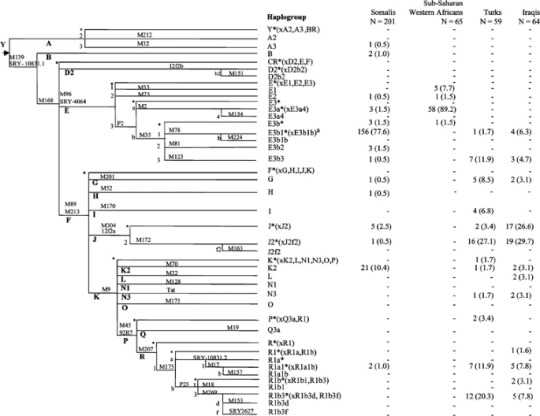
View On WordPress
#bialleliMarkers#SNPs microsatelliteLoci E3b1 SomaliPopulation#Ychromosome#somalia#Somali Origin#somaliland#Somali people origin#Somali DNA#human origins#dna structure
0 notes
Text
Naming International POC Characters: Do Your Research.
This post is part of a double feature for the same ask. First check out Mod Colette's answer to OP's original question at: A Careful Balance: Portraying a Black Character's Relationship with their Hair. Below are notes on character naming from Mod Rina.
~ ~ ~
@writingraccoon said:
My character is black in a dungeons and dragons-like fantasy world. His name is Kazuki Haile (pronounced hay-lee), and his mother is this world's equivalent of Japanese, which is where his first name is from, while his father is this world's equivalent of Ethiopian, which is where his last name is from. He looks much more like his father, and has hair type 4a. [...]
Hold on a sec.
Haile (pronounced hay-lee), [...] [H]is father is this world’s equivalent of Ethiopian, which is where his last name is from.
OP, where did you get this name? Behindthename.com, perhaps?

Note how it says, “Submitted names are contributed by users of this website. Check marks indicate the level to which a name has been verified.” Do you see any check marks, OP?
What language is this, by the way? If we only count official languages, Ethiopia has 5: Afar, Amharic, Oromo, Somali, & Tigrinya. If we count everything native to that region? Over 90 languages. And I haven't even mentioned the dormant/extinct ones. Do you know which language this name comes from? Have you determined Kazuki’s father’s ethnic group, religion, and language(s)? Do you know just how ethnically diverse Ethiopia is?
~ ~ ~
To All Looking for Character Names on the Internet:
Skip the name aggregators and baby name lists. They often do not cite their sources, even if they’re pulling from credible ones, and often copy each other.
If you still wish to use a name website, find a second source that isn’t a name website.
Find at least one real life individual, living or dead, who has this given name or surname. Try Wikipedia’s lists of notable individuals under "List of [ethnicity] people." You can even try searching Facebook! Pay attention to when these people were born for chronological accuracy/believability.
Make sure you know the language the name comes from, and the ethnicity/culture/religion it’s associated with.
Make sure you understand the naming practices of that culture—how many names, where they come from, name order, and other conventions.
Make sure you have the correct pronunciation of the name. Don’t always trust Wikipedia or American pronunciation guides on Youtube. Try to find a native speaker or language lesson source, or review the phonology & orthography and parse out the string one phoneme at a time.
Suggestions for web sources:
Wikipedia! Look for: “List of [language] [masculine/feminine] given names,” “List of most common [language] family names,” “List of most common surnames in [continent],” and "List of [ethnicity] people."
Census data! Harder to find due to language barriers & what governments make public, but these can really nail period accuracy. This may sound obvious, but look at the year of the character's birth, not the year your story takes place.
Forums and Reddit. No really. Multicultural couples and expats will often ask around for what to name their children. There’s also r/namenerds, where so many folks have shared names in their language that they now have “International Name Threads.” These are all great first-hand sources for name connotations—what’s trendy vs. old-fashioned, preppy vs. nerdy, or classic vs. overused vs. obscure.
~ ~ ~
Luckily for OP, I got very curious and did some research. More on Ethiopian & Eritrean naming, plus mixed/intercultural naming and my recommendations for this character, under the cut. It's really interesting, I promise!
Ethiopian and Eritrean Naming Practices
Haile (IPA: /həjlə/ roughly “hy-luh.” Both a & e are /ə/, a central “uh” sound) is a phrase meaning “power of” in Ge’ez, sometimes known as Classical Ethiopic, which is an extinct/dormant Semitic language that is now used as a liturgical language in Ethiopian churches (think of how Latin & Sanskrit are used today). So it's a religious name, and was likely popularized by the regnal name of the last emperor of Ethiopia, Haile Selassie (“Power of the Trinity”). Ironically, for these reasons it is about as nationalistically “Ethiopian” as a name can get.
Haile is one of the most common “surnames” ever in Ethiopia and Eritrea. Why was that in quotes? Because Ethiopians and Eritreans don’t have surnames. Historically, when they needed to distinguish themselves from others with the same given name, they affixed their father’s given name, and then sometimes their grandfather’s. In modern Ethiopia and Eritrea, their given name is followed by a parent’s (usually father’s) name. First-generation diaspora abroad may solidify this name into a legal “surname” which is then consistently passed down to subsequent generations.
Intercultural Marriages and Naming
This means that Kazuki’s parents will have to figure out if there will be a “surname” going forward, and who it applies to. Your easiest and most likely option is that Kazuki’s dad would have chosen to make his second name (Kazuki’s grandpa’s name) the legal “surname.” The mom would have taken this name upon marriage, and Kazuki would inherit it also. Either moving abroad or the circumstances of the intercultural marriage would have motivated this. Thus “Haile” would be grandpa’s name, and Kazuki wouldn’t be taking his “surname” from his dad. This prevents the mom & Kazuki from having different “surnames.” But you will have to understand and explain where the names came from and the decisions dad made to get there. Otherwise, this will ring culturally hollow and indicate a lack of research.
Typically intercultural parents try to
come up with a first name that is pronounceable in both languages,
go with a name that is the dominant language of where they live, or
compromise and pick one parent’s language, depending on the circumstances.
Option 1 and possibly 3 requires figuring out which language is the father’s first language. Unfortunately, because of the aforementioned national ubiquity of Haile, you will have to start from scratch here and figure out his ethnic group, religion (most are Ethiopian Orthodox and some Sunni Muslim), and language(s).
But then again, writing these characters knowledgeably and respectfully also requires figuring out that information anyway.
~ ~ ~
Names and naming practices are so, so diverse. Do research into the culture and language before picking a name, and never go with only one source.
~ Mod Rina
#asks#language#languages#linguistics#east africa#african#immigration#ethiopian#names#naming#research#resources#writeblr#character names#character name ideas#rina says read under the cut. read it
4K notes
·
View notes
Text

Why are East Africans darker than West Africans?
Most to all African people vary in color.
This question is like saying why do all Irish people only have red hair. Of course that is a grand generation. There's Irish people without red hair, and there's people with red hair that aren’t Irish.

Somali man
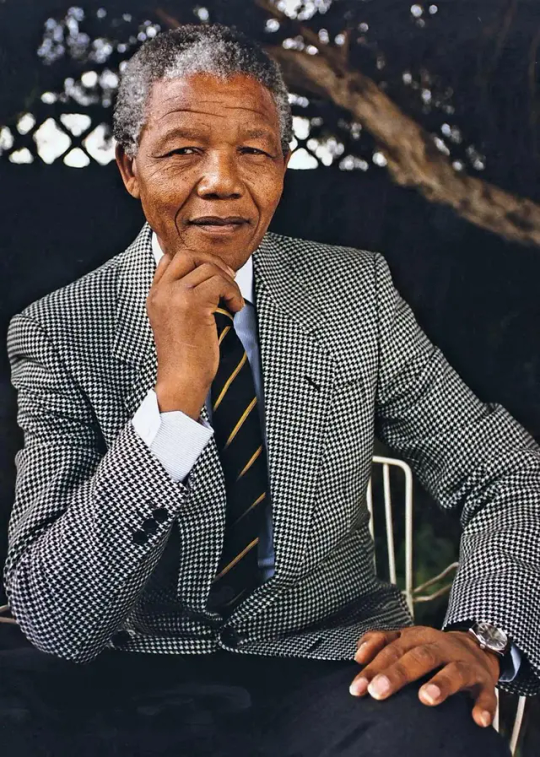
Xhosa man

Wolof Woman

Igbo Woman

Congolese Woman

Zulu Man


Fulani Women





Africans we are the most diverse people on the planet
#african#afrakan#kemetic dreams#brownskin#africans#afrakans#brown skin#african culture#skin tones#african diversity#shewa#ethiopian#wolof#congolese#somali
38 notes
·
View notes
Text
Haiiii I made headcanons for all of the Dragon Age Origins and Awakening Companions :3
(Note: Oghren doesn't get one bc. he makes me uncomfy.)
Origins:
Alistair: Abyssinian; Extremely energetic and athletic, like observing people and need a lot of attention
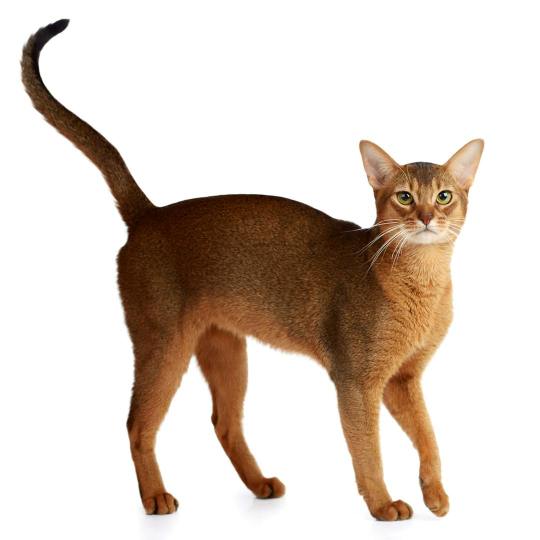
Morrigan: Siamese; incredibly intelligent, mischievous cats. Not great in groups unless well trained

Leliana: Scottish Fold; Adaptable, friendly, family cats who get along great with most other cats

Sten: Persian; Curious yet quiet, very solitary cats that can take a lot of time to warm up to people, tend to bond best with a single person
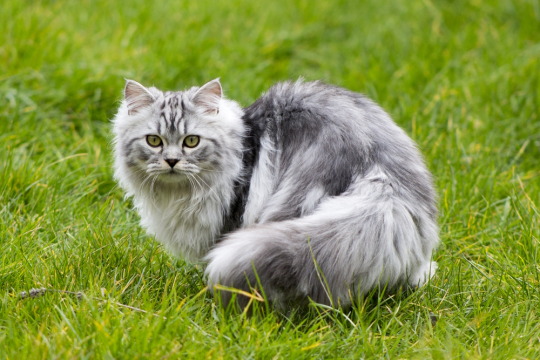
Wynne: Russian Blue; Elegant and intelligent, somewhat aloof and affectionate cats, adapt fine to groups but prefer to be one-on-one with people
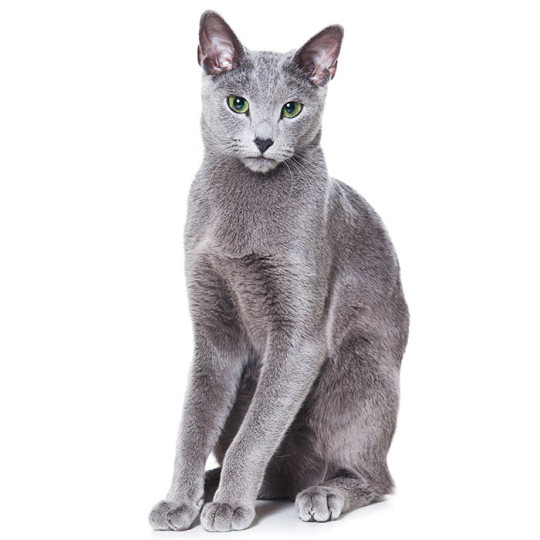
Zevran: Somali; Very chaotic cats unless very well trained, energetic, intelligent, and need a lot of attention and playtime to keep entertained
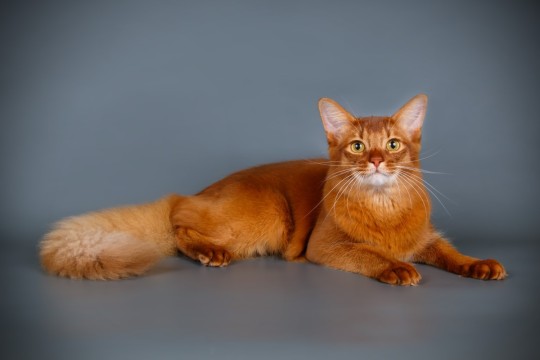
Shale: Manx; High prey-drive, affectionate, talkative, and tend to bond best one-on-one
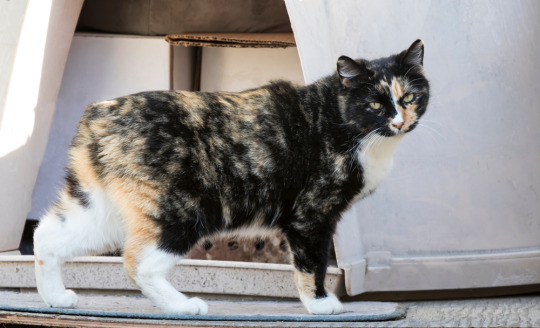
Awakening:
Anders: Bengal; Curious and adaptive learners, tend to be good therapy cats, very talkative
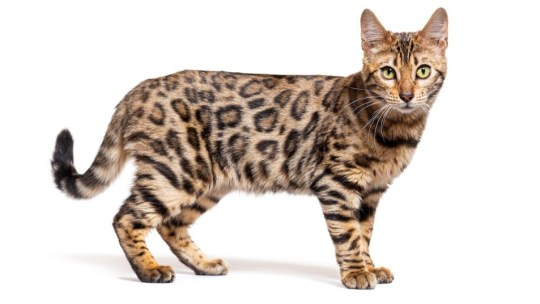
Nathaniel: Bombay; Mischievous, sneaky, and outgoing, do well in homes where they get to be the center of attention

Justice: Sphynx; Curious, social, active cats who like to be apart of whatever activity is happening, tend to mimic what people do
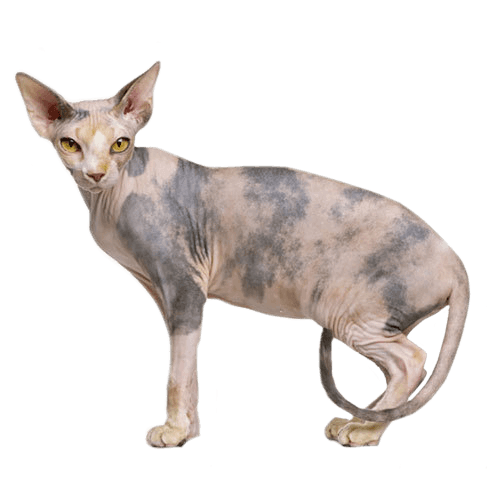
Sigrun: Burmese; Small, athletic, and friendly, they tend to get along well with other cats and loves to play

Velanna: Toyger; highly intelligent and energetic, require a lot of attention and are very talkative when they want something

I plan on doing this for the DA2 and Inquisition companions when I get there :3
#dragon age#dragon age origins#dragon age awakening#alistair theirin#alistair#morrigan#leliana#sten#wynne#zevran#zevran arainai#shale#anders#nathaniel howe#spirit of justice#sigrun#velanna#da#dao#daa#erm i hope this isnt cringe#my post#so many fucking characters to tag god damn#special thanks to Jamie my beloved for enabling me to ramble abt cats#it means the world 2 me
33 notes
·
View notes
Text
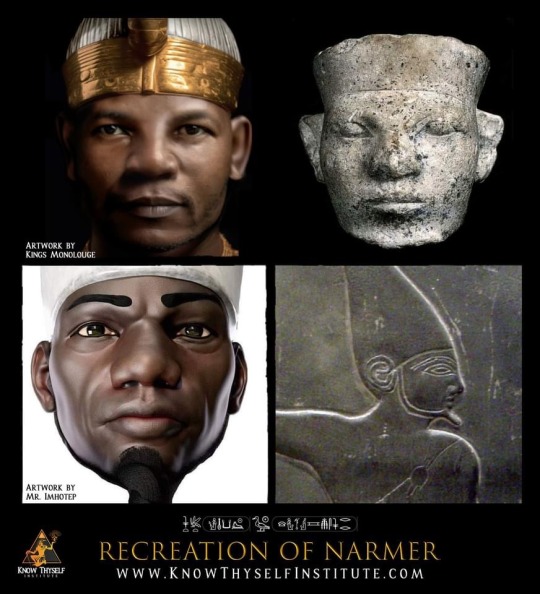
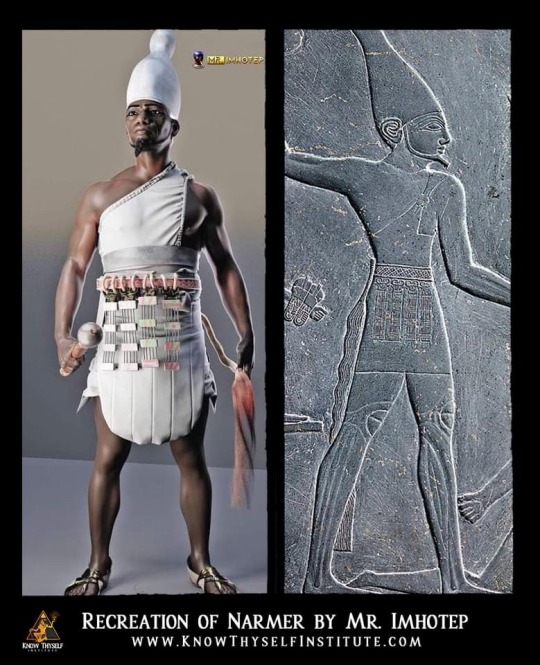


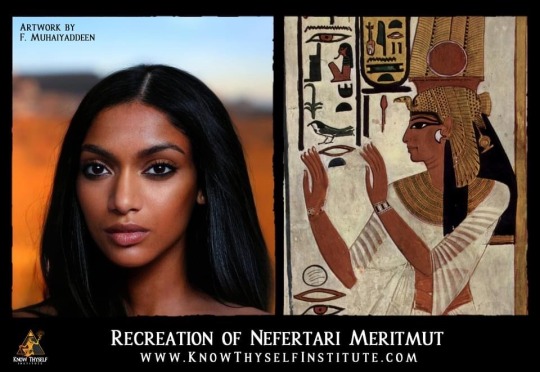

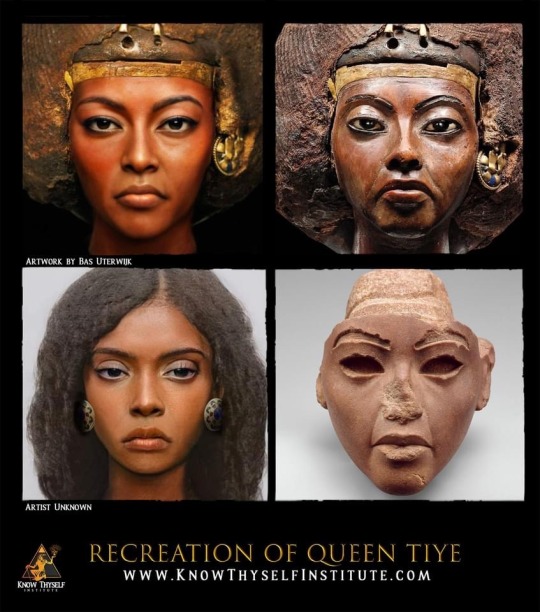


ORIGINS OF HAPI (NILE) VALLEY CIVILIZATION
The progenitors of the Nile Valley civilization were Nilo-Saharan peoples who migrated to the Hapi (Nile) Valley from the Green Sahara, Nubia and Northeast Africa. The cattle cults of Het-Heru (Hathor), spiritual beliefs, iconography and cultural motifs associated with the old Kingdom can be traced to these regions prior to the unification of the two lands. The science of mummification began in Libya with the 5600 year old Tashwinat Mummy, known as the “Black Mummy of the Green Sahara''. The Black Mummy predates the oldest Kemetic mummy by over 1000 years. Astronomy and the study of the procession of the equinox began in South Africa at the site of the Adams Calendar Stone Circle and continued at the Napta Playa Stone circle located in modern day Sudan. This 7000 year old ceremonial center dried out around 3400 BC and they transferred their knowledge into the Nile Valley. The earliest images of Pharaonic Kingship were found in Nubia at the site of Qustul were the oldest depiction of Pharaonic Kingship is shown on the Qustul incense Burner. The original populations of the Nile Valley were no different than modern Sudanese, Ethiopian, Eritrean and Somali populations of today with a mixture of western Eurasians via the Levant whom for the most part settled in the Delta region. The cultural overlap of Kush and Kemet existed from the very dawn of Hapi Valley civilization and the cultural fusion was expressed in the customs and spiritual beliefs of its early inhabitants. These ancient traditions are continually practiced in Africa to this day.
Below are the results from a genome project conducted by Dr. Shomarka Keita, a Research Affiliate and Biological Anthropologist in the Department of Anthropology at the Smithsonian Institution and Dr. A. J. Boyce, who works at the Institute of Biological Anthropology and St. John's College
Oxford University.
PROJECT MUSE
Genetics, Egypt, and History: Interpreting Geographical Patterns of Y Chromosome Variation
IV, XI, V=Nilotic African
VII, VIII=Near Eastern
235 S.O.Y. Keita and A. J. Boyce
Early speakers of Nilosaharan and Afroasiatic apparently interacted based on the evidence of loan words (Ehret, personal communication). Nilosaharan’s current range is roughly congruent with the so-called Saharo-Sudanese or Aqualithic culture associated with the less arid period (Wendorf and Schild 1980), and therefore cannot be seen as intrusive. Its speakers are found from the Nile to the Niger rivers in the Sahara and Sahel, and south into Kenya. The eastern Sahara was likely a micro-evolutionary processor and pump of populations, who may have developed various specific sociocultural (and linguistic) identities, but were genealogically “mixed” in terms of origins.
These identities may have further crystallized on the Nile, or fused with those of resident populations that were already differentiated. The genetic profile of the Nile Valley via the fusion of the Saharans and the indigenous peoples were likely established in the main, long before the Middle Kingdom. Post-neolithic/predynastic population growth, as based on extrapolations from settlement patterns (Butzer 1976) would have led to relative genetic stability. The population of Egypt at the end of the pre-dynastic is estimated to have been greater than 800,000, but was not evenly distributed along the valley corridor, being most concentrated in locales of important settlements (Butzer 1976). Nubia, as noted, was less densely populated.
Interactions between Nubia and Egypt (and the Sahara as well) occurred in the period between 4000 and 3000 BCE (the predynastic). There is evidence for sharing of some cultural traits between Sudan and Egypt in the neolithic (Kroeper 1996). Some items of “material” culture were also shared in the phase called Naqada I between the Nubian A-Group and upper Egypt (~3900-3650 BCE). There is good evidence for a zone of cultural overlap versus an absolute boundary (Wilkinson 1999 after Hoffman 1982, and citing evidence from Needler 1984 and Adams 1996). Hoffman (1982) noted cattle burials in Hierakonpolis, the most important of predynastic upper Egyptian cities in the later predynastic. This custom might reflect Nubian cultural impact, a common cultural background, or the presence of Nubians.
Whatever the case, there was some cultural and economic bases for all levels of social intercourse, as well as geographical proximity. There was some shared iconography in the kingdoms that emerged in Nubia and upper Egypt around 3300 BCE (Williams 1986). Although disputed, there is evidence that Nubia may have even militarily engaged upper Egypt before Dynasty I, and contributed leadership in the unification of Egypt (Williams 1986). The point of reviewing these data is to illustrate that the evidence suggests a basis for social interaction, and gene exchange.
236 S.O.Y. Keita and A. J. Boyce
There is a caveat for lower Egypt. If neolithic/predynastic northern Egyptian populations were characterized at one time by higher frequencies of VII and VIII (from Near Eastern migration), then immigration from Saharan sources could have brought more V and XI (Nilo-Saharan) in the later northern neolithic. It should further be noted that the ancient Egyptians interpreted their unifying king, Narmer (either the last of Dynasty 0, or the first of Dynasty I), as having been upper Egyptian and moving from south to north with victorious armies (Gardiner 1961, Wilkinson 1999). However, this may only be the heraldic “fixation” of an achieved politi- cal and cultural status quo (Hassan 1988), with little or no actual troup/population movements. Nevertheless, it is upper Egyptian (predy- nastic) culture that comes to dominate the country and emerges as the basis of dynastic civilization. Northern graves over the latter part of the predynastic do become like those in the south (see Bard 1994); some migration to the north may have occurred—of people as well as ideas.
238-239 S.O.Y. Keita and A. J. Boyce
After the early late pleistocene/holocene establishment of Afroasiatic-speaking populations in the Nile valley and Sahara, who can be inferred to have been predominantly, but not only V (and XI), and of Nilosaharan folk in Nubia, Sudan, and Sahara (mainly XI and IV?), mid- holocene climatic-driven migrations led to a major settlement of the valley in upper Egypt and Nubia, but less so in lower Egypt, by diverse Saharans having haplotypes IV, XI, and V in proportions that would significantly influence the Nile valley-dwelling populations.
These mid-Holocene Saharans are postulated to have been part of a process that led to a diverse but connected metapopulation. These peoples fused with the indigenous valley peoples, as did Near Easterners with VII and VIII, but perhaps also some V. With population growth the genetic profiles would become stabilized. Nubian and upper Egyptian proximity and on some level, shared culture, Nubia’s possible participation in Egyptian state-building, and later partial political absorption in Dynasty I, would have reinforced biological overlap (and been further “stabilized” by ongoing population growth).
Source:
https://muse.jhu.edu/article/187884
HEAD to HEAD: Ancient Egypt Reconstructions COMPARED (Bas Uterwijk vs TKM): https://www.youtube.com/watch?v=E8iN6EFVTbQ&t=35s
Visit A Virtual Museum:
https://www.knowthyselfinstitute.com/museum
"I have not spoken angrily or arrogantly. I have not cursed anyone in thought, word or deeds." ~35th & 36th Principals of Ma'at
141 notes
·
View notes
Note
Aquila dear, I cannot wait to hear your opinion on the choice of raven/crow species for Matthew and Jessamy 💛 Would you have any headcanon on which species Lucien(ne) might have been back when they were Dream's raven ? 👀
Hi! So sorry it's taken so long to get around to this! I have so many thoughts!!!
I'll start with the caveat that the distinction between crow and raven is not scientific. They both refer to members of the genus Corvus and there is no clear distinction between what is a crow and what is a raven. As such, I don't get too worked up about the differences in common names.
Matthew is a common raven (Corvus corax). I think this fits him for a number of reasons.
He's American! We only have two "raven" species here (and four crows but that's besides the point), and the common raven is by far the more widely distributed species compared to the Chihuahuan Raven, which is as its name implies, restricted to the areas in and around the Chihuahuan desert. I'm not sure if we know exactly where he's from, but he has a general American accent to me, so I can get away with placing him virtually anywhere on the West Coast, Appalachians or Northwest.
Common ravens are very gregarious! They're often seen in mated pairs or flocks. Matthew prefers to stay by Dream's side over and over and builds a pretty deep bond with him over the course of their relationship.
Play! Common ravens are often observed engaging in play, like somersaulting in flight or making toys out of twigs to share with others. To me, Matthew is very irreverent and playful in his own way, his crude behavior and language being a prime example.
I think common raven is such a great choice! I'm thrilled to bits that they had real ravens play his part in the show, it was honestly one of the first things I looked up about the production because I was just blown away that the birds were actually behaving like birds!!! But that's another rant for another time about animal portrayal in media.
Onto Jessamy! I haven't read the comics (where she appears to be a common raven as well, from some cursory research), so this will all be based on what little we get of her in season 1 of the show.
Jessamy is a pied crow (Corvus albus). According to the wikipedia entry for this species, it is said to be considered
"a small crow-sized raven, especially as it can hybridise with the Somali crow (dwarf raven) where their ranges meet in the Horn of Africa. Its behaviour, though, is more typical of the Eurasian carrion crows, and it may be a modern link (along with the Somali crow) between the Eurasian crows and the common raven." (Source)
Like I said, there's no reliable division between crow and raven and it's just the common names, so there's no big deal in her being portrayed as a species that has "crow" in its name.
Sociality. Pied crows are, similarly to the common raven, typically found in mated pairs or small flocks. Jessamy is very loyal to Dream, staying by his side during his captivity until her untimely death. I would argue that most Corvus species would be a good fit as they tend to stay with the individuals they are bonded to, but I see no reason why pied crow wouldn't be chosen over another species!
Distribution. While we don't have any idea where Jessamy was from when she was alive, she is also given a widely distributed species that we could reasonably place her in many parts of Africa, along either coast up until the Sahara Desert, but not in the thick rainforests of countries like the Democratic Republic of Congo.
Exposure to another species! The Sandman was written by an English author, originally scripted and performed in English, and in my opinion, culturally directed towards the Anglosphere. As such, folks who speak English as their first language may have never heard of the pied crow, and may only be familiar with the common raven! I think its a great way to get people to investigate more into a bird they've never seen before.
Now, let's talk about Lucienne! We know she was Dream's first raven, but not really any timing about when he first took a raven companion. As such, I'll simply consider any extant Corvus species for her. She has an English accent, so I will simplify my choices to species found in England. I'm just making this assumption without much reasoning other than it's fun to imagine that the ravens come into being reflecting species found where they lived as humans.
I'm going to choose common raven (C. corax) for Lucienne as well, but for different reasons than why it's a suitable species for Matthew. They are, after all, very different personalities.
Mainly, common ravens are highly intelligent! Lucienne is the Dreaming's librarian at present, and would thus have to have very high reasoning and problem solving skills. This is typical for common ravens and corvid intelligence has been highly studied in this species!
My other big reason for choosing this species is that, well, you can't beat a classic. If Lucienne is the first raven, then it's fitting that she be the type species for the genus Corvus and the first thing people think of when they hear "raven."
Thank you so much for asking and giving me the opportunity to smash my two main interests together like I'm mixing 2 colors of playdoh in preschool <3 <3
109 notes
·
View notes
Text

15 𝙄𝙣𝙩𝙚𝙧𝙚𝙨𝙩𝙞𝙣𝙜 𝙁𝙖𝙘𝙩𝙨 𝘼𝙗𝙤𝙪𝙩 𝙀𝙩𝙝𝙞𝙤𝙥𝙞𝙖🇪🇹
1. The Ethiopian 🇪🇹 calendar is different from the Gregorian calendar. There are thirteen months in the Ethiopian calendar, which means they are currently in 2014.
2. Ethiopians 🇪🇹 also measure the hours of a day to a different schedule based on the logic that the clock starts when the day does. Ethiopia, however, observes 13 calendar months per year. This makes the Ethiopian calendar 7 years behind the rest of the world.
3. Ethiopia 🇪🇹 is the only African country never to have been brought under colonial rule. The Itàlians tried but failed woefully and were defeated by the solid Ethiopian forces.
4. Ethiopia 🇪🇹 has the world's 0ldest Bible and the most unique.
5. Ethiopia 🇪🇹 is home to one of the world's best coffee. In fact, coffee production is huge in Ethiopia.
6. According to some archaeological findings, Ethiopia 🇪🇹 is the cradle of humànkind. Meaning lifè actually started in Ethiopia.
7. In 1960, an Ethiopian named Abebe Bikila became the first Black African to win gold in the Olympics. He won it by running barefoot.
8. Addis Ababa's name translates to ‘New Flower’ in Amharic. The city is one of the oldest cities in the world.
9. Ethiopia 🇪🇹 is home to some of the world's tastiest, healthiest and most diverse cuisines on the continent of Africa.
10. The biggest festival in Ethiopia, Timket, is a three-day annual festival that honours the baptism of Jesus Christ in the river Jordan. It's one of the world's largest festivals that takes place annually. The festival attracts millions of people from all over the world.
11. Ethiopia 🇪🇹 has the most UNESCO World Heritage Sites on the continent. Ethiopia takes first place as the African country with the most UNESCO World Heritage sites. There are 9 total ranging from religious sites to natural areas. Among them are the Simien National Park, Konso Cultural Landscape and the rock-hewn churches.
12. Over 80 languages are spoken in Ethiopia. There are over 80 languages spoken with English being the language of educational systems in addition to local languages which include Oromo, Amharic, Somali and Tigrinya.
13. Over half of Africa’s mountains are in Ethiopia 🇪🇹 Along with Ethiopia’s incredible cultural and historical significance, the natural beauty is in a league of its own. In addition to a gorgeous landscape of low desserts and volcanic plateaus, Ethiopia is incredibly mountainous. In fact, around 70% of Africa’s mountains are in Ethiopia.
14. Ethiopia 🇪🇹 is Africa’s oldest country. Originally founded in 980 BC, Ethiopia is the oldest independent nation on the continent. Additionally, Ethiopia has remnants of some of the most ancient human beings on earth dating back millions of years making it one of the most important archaeological areas in the world. Not only that, but it is the second most populated country with more than 106 million people.
15. Ethiopia 🇪🇹 is the only country in the world with its own unique Alphabet.
49 notes
·
View notes
Text
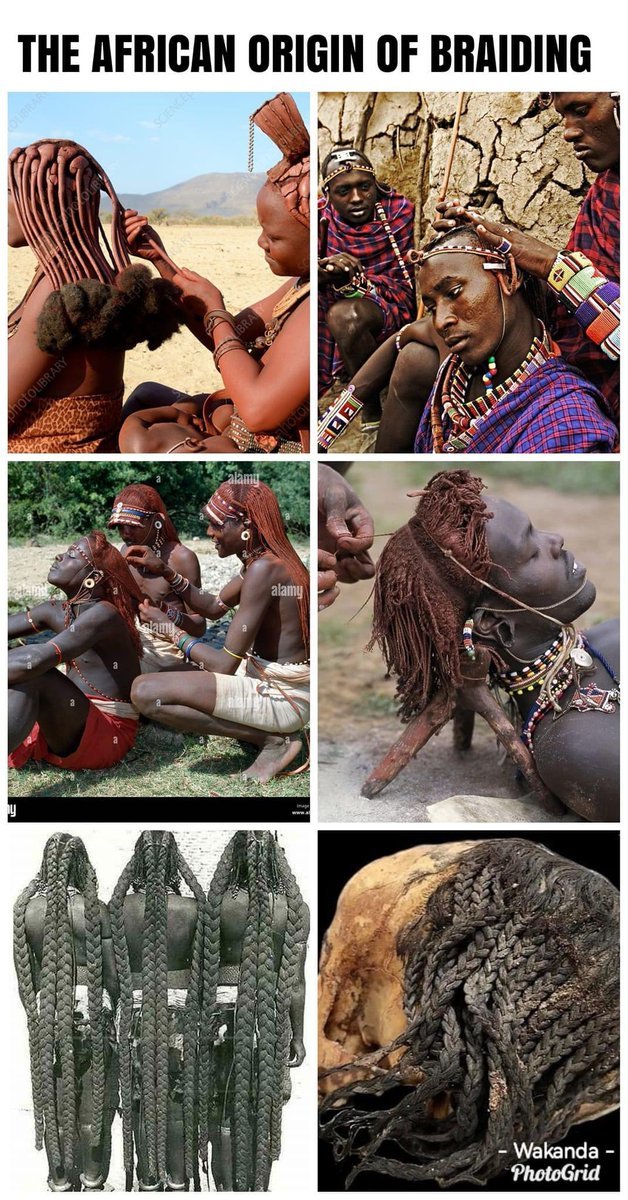
Typical African on Twitter
@Joe__Bassey
THE AFRICAN ORIGIN OF BRAIDING The origin of braids can be traced back 5000 years in African culture to 3500 BC—they were very popular among women. Braiding started in Africa with the Himba people of Namibia. The country’s Mbalantu ethnicity uses eembuvi braids as an initiation into womanhood – our first examples of single braids or “box braids". In Angola, among certain tribes, hair grooming was an activity trusted only by other family members — something that women were taught at a young age and encouraged to participate in throughout their lives to promote womanhood. The origins of the ever-popular Bantu Knots have been traced to the Bantu people who exist across central and Southern Africa. “South Africa’s “Zulu Knots” are said to be the original manifestation of the style, and South Africa is also credited for the invention of “Box braids”, with evidence of the style being traced back to 3500 BCE. Braiding’s roots in East Africa have been traced back to 3500 BC, with cornrows (called Kolese braids in Yoruba) maintaining the top spot in popularity for just as long. Historically, Somali women have been recorded donning long, small braids when approaching puberty. Ethiopia has maintained an admirably close relationship with its traditional forms of braiding. In the Southwestern Omo Valley, the Hamar people have perfected their hairstyles as a means to dictate male worth and female marital status. The importance of braids in communicating identity is a rich part of Uganda’s history, too. In Kenya, the Maasi and Kikuyu tribes have donned their famed matted braids, intricate beading, and gold detailings ever since. West Africa boasts an abundance of hair braiding styles, many of which have influenced global African culture and trends for decades. The Fula people, whose 30 million strong population exists across West Africa, gifted the world with Fulani braids. In Ghana, the iconic Banana or Ghana braids have gained favor for their easy application, upkeep, and excellence in providing protection to natural Black hair. The first examples of this way of braiding are traced back to hieroglyphics and sculptures found around 500 BC. Similarly, Nigeria’s rich history of braiding can be traced back to a clay sculpture dated to 500 BCE depicting a cornrowed member of the Nok tribe. Mali's Dogon people has various spiritual idols depicting cornrowed spiritual leaders, and the retained tradition of The Dama dance have allowed us the privilege of understanding the bewildering society that contributed to our understanding of our universe. In Sierra Leone, Mende people's hair is closely tied to femininity and is juxtaposed with the way forests grow out of the Earth – the vegetation covering Mother Earth grows skyward the way Afro-textured hair grows out of the head. Senegal’s Senegalese Twists or “Rao” as they’re known locally came in vogue as an alternative means of creating individual, long braids – if locs or “box braids” aren’t your style. Gambian warriors were known to march off to war with tightly coiled braids, too. The Mangbetu people of the Democratic Republic of Congo, known for their practice of wrapping their skulls into a cone shape from infancy, locally referred to as “Lipombo, ” the elongated heads were then adorned with braids plaited into a crowned, basket shape called edamburu. Cameroon’s bountiful Fulani community has kept many of their hair traditions well and alive, while the region’s Bantu population participated in the popularity of the now-famed ‘Bantu knots’. In Chad, women of the Basara ethnicity are known for their thick, long, luscious hair – often plaited into waist-long individual braids. In Kemet around 1600 BCE, hair braiding amongst women of royalty, nobility, and concubines was adorned with gold, beads, and perfumed grease, while common folk kept to simpler styles necessary to get work done. #Africa
9 notes
·
View notes
Text
Unnoticed and unnoted there indeed — but not by Turse. In fact, he’s never stopped noticing that grim reality. As he wrote at The Intercept only recently, “During the first 20 years of the war on terror, the U.S. conducted more than 91,000 airstrikes across seven major conflict zones — Afghanistan, Iraq, Libya, Pakistan, Somalia, Syria, and Yemen — and killed up to 48,308 civilians, according to a 2021 analysis by Airwars, a U.K.-based airstrike monitoring group.” So, today, it seems all too appropriate that he should focus on one tiny aspect of that never-ending war on terror he’s followed all these years deep into Africa — two dead Somali civilians, a child and her mother, taken out by an American drone and how little anyone responsible in this country gives a damn.
Tom Engelhardt at Tom Dispatch. Nick Turse, Sorry, But Not Sorry in Somalia
Engelhardt in preface to Nick Turse's reporting, "Remote Warfare and Expendable People." Tom Dispatch is such a valuable news source publishing three original articles weekly. Engelhardt points ot Nick Turse's first article published there in 2003.
I'm a casual observer, just some guy on the Internet. I'm regularly moved to tears by the news of the day. I wonder how a careful observer like Nick Turse survivea and carries on. But I am very grateful he does.
6 notes
·
View notes
Text

TIM! the final of the main / original four truenorth guys. its hard to pick out a fav amongst them but i really do have a soft spot for tim. dude's the most normal guy here but loves everyone nonetheless. bio below the cut!
Timothy Houston
Somali, He / Him, 26
Calm and level headed musician
A talented young Campfolker. Timothy is the most mature of the main four, carrying a laid back and down to earth personality, which makes him popular with most younger Campfolk alongside his musical talents. Similar to Mattias, he’s the most social, having plenty of friends and acquaintances outside of his main friend group, but he loves his three friends the most out of anyone, constantly looking out for them even if they don’t notice. He’s never had anyone else matter to him as much as they do, especially Mattias–who Tim sees as a sort of partner in crime. While he is the most relaxed of the group, he carries a hefty amount of sarcasm and often playfully teases his friends while encouraging and supporting them, a common target of this sarcasm being Emmett. He spends most of his days playing music in the Center Star or working in the Blooming Bakery, which is how he makes most of his money for the house and his friends. On the side, he secretly works with Alder to create new recipes for the bakery and his friends.
His muses are his friends. He spreads Emmett’s views of hope through his music, and hopes that his songs will inspire someone, anyone, to stand up to Caesar and change things for the better. His outlook is much calmer than Mattias’, but he still feels that the cruelty of the people in power needs to end, and that cruelty must be done back onto those who’ve perpetuated it. What he isn’t aware of is that the person he inspires the most is his greatest supporter and dearest “friend”–Mattias.
6 notes
·
View notes
Text
A woman has been found guilty of taking a three-year-old British child to Kenya for female genital mutilation (FGM).
Amina Noor, 39, is the first person to be convicted of assisting a non-UK person to perform FGM.
Noor, from Harrow in north-west London, took the child to a private house for the procedure in 2006.
She had told the Old Bailey the mutilation is done for cultural reasons and was a procedure she herself had undergone as a child.
Noor, who was born in Somalia but has British citizenship, will be sentenced on 20 December.
It was only in 2015 that the girl - who is now aged 21 and who cannot be identified - confided to a schoolteacher that she had suffered FGM and police were informed.
Following an examination at University College Hospital in 2019 it was found that the girl's clitoris had been completely removed.
'No threats'
Giving evidence at her trial, Noor claimed she had come under cultural pressure to have the procedure performed.
Noor told her trial that she and another woman had taken the child in a tuk-tuk vehicle and she had been told to wait outside a house.
She claimed that she had only expected the girl's genitals to be "touched" in a way that would cause them to bleed.
However, the prosecution said the jury could be sure the defendant knew that an act of FGM was to be performed - whether or not that was the removal of the girl's clitoris or some form of physical injury for which there was no medical purpose.
Prosecutor Deanna Heer KC said Noor had repeatedly denied to police that she had been threatened to force her to agree to the procedure.
"She was asked three times if she had been threatened and three times she said there were no threats," Ms Heer said.
But in her defence Noor claimed she feared being "disowned and cursed" by the community if she did not hand over the girl.
The prosecution also drew attention to the defendant's behaviour at the time the FGM was carried out - for example, she had not asked whether the people involved were doctors or insisted on being present for the procedure.
FGM is a practice that is very widespread among the Somali community in East Africa, the court heard, with United Nations figures suggesting that 94% of women of Somali origin living in Kenya have undergone the procedure.
10 notes
·
View notes
Text
Beyond Afrocentrism: Prerequisites for Somalia to lead African de-colonization and de-Westernization
What follows is the quasi-totality of my response to a Somali scholar, intellectual and activist, who happened to be a very good personal friend since the early 2010s and my days in Somalia. Being a perspicacious reader, my good friend, who originates from two different tribal backgrounds and has an unmatched knowledge of his great but recently (since 1991) beleaguered nation, noticed several recent articles of mine in which I call for a definite and irreversible replacement of the Anglo-French colonial rule in Africa with a genuine, secular African-Chinese-Indian-Russian alliance.

The Great Cat - Horus (Messiah) defeats the Ancient Serpent - Seth (Anti-Messiah); wall painting from the Tomb of Pashedu (TT3) in Deir el Medina (Luxor West)
Afrocentrism will be a total failure if it is thought to be just an African intellectual's thought, idea, theory or ideology. Theorizing is already part of Western intellectuals' falsehood and evildoing. Philosophy is nonsensical, absurd, false and inhuman. There was never 'philosophy' in Africa, because it would be viewed as deviation and decay. Contrarily, in Ancient Africa there were Truth, Transcendental Spirituality, Primordial Myth, World Conceptualization, Supratemporal Eschatology, and Spiritual-Material Synergy. So, the primary tasks of African Afrocentric intellectuals involve the irrevocable obliteration of all Western terms and their replacement with Oriental African concepts, notions, terms, values and virtues. Consequently, there cannot be "an Afrocentric University", because this term follows a Western pattern. Offering herewith an example, I suggest that every institution in which African students will learn the truth should be called after the Ancient Egyptian term "the Place of Truth" and the instructors "Servants in the Place of Truth". This title was associated at the time with all the great scholars specializing in mummification and in the preparation of the human soul for the Hereafter. However, this has always been the value of life, learning and knowledge according to all the varieties of African culture: material life is subject to moral judgments that enable us to gain eternal life.
Contents
Introduction
I. Decolonization and the failure of the Afrocentric Intelligentsia
II. Afrocentric African scholars should have been taken Egyptology back from the Western Orientalists and Africanists
III. Western Usurpation of African Heritage must be canceled.
IV. Afrocentrism had to encompass severe criticism and total rejection of the so-called Western Civilization
V. Afrocentrism as a form of African Isolationism drawing a line of separation between colonized nations in Africa and Asia
VI. General estimation of the human resources, the time, and the cost needed
VII. Decolonization means above all De-Anglicization and De-Francization
Introduction
Realizing what is at stake and being well acquainted with earlier African attempts for a final decolonization (notably the intellectual-academic sphere of Afrocentrism and the political activists of African Renaissance), my friend, who has the same age with me and who studied, lived, worked and prospered in the USSR, Canada, Yemen and Pakistan, wrote to ask me how Somalia could eventually contribute to or lead the African decolonization and de-Westernization movement, thus taking the Black Continent to the next stage and justifying the great expectations that were created across Africa back in 1960, due to the independence and the unification (of only two out of the five parts) of Somalia.
At this point, I have to add that the present response is only the first of three letters that I planned to send to my friend. The urgent need for worldwide decolonization and de-Westernization has become a major issue for great nations, organizations and alliances, like the BRICS+. Many people across the world would therefore question the entire conversation, stating that presently Somalia is too small, too weak, and too disunited in order to possibly undertake international tasks that seem to be best suited rather to some of the world's leading states.
I believe that, although this approach may be shared by many people, it is ostensibly very shallow. This is so because stronger a nation is, more difficult it becomes for their rulers, elites, and people to undertake an in-depth self-criticism, reassessment, and restart or partly rectification. In other words, a better organized nation is by definition more conservative and therefore less inclined to changes; these traits and conditions have been attested repeatedly throughout History.
Consequently, when it comes to colonization and Westernization, self-scrutiny must be very deep, and this -at the national level- can be extremely painful. That is why, in Russia, de-Westernization will be a far more difficult process to be carried out than in India.
Taken into consideration that Westernization (not only behavioral-cultural but mainly educational-academic-intellectual) is tantamount to alteration, corruption and degeneration, one has to underscore at this point that national identity is not necessarily proportionate to national independence. It is quite possible that an educationally-academically-intellectually corrupted nation, although in possession of an independent state, has minimal national consciousness (because of their entirely Westernized education), whereas an enslaved nation struggling to achieve national independence may have fully preserved their national identity and intellectual originality.
Back in January 2021, I explained exactly this to an Oromo friend, who wrote to ask me why Egypt does not help the Oromo liberation movements achieve national independence for Oromia and in the process demolish the obsolete and genocidal state of Abyssinia (Fake Ethiopia). Egypt is an independent state without national consciousness of historicity whereas the Oromos are a non-independent nation with emphatically strong Cushitic national identity and cultural originality. It took me a series of five articles to fully respond at the time; in the last article of the series, one can find titles of and links to the earlier parts:
I expand on these topics, because there is a multitude of parameters in the much needed effort of African decolonization and educational-academic-intellectual de-Westernization. To offer an example, I have to say that even the nefarious term "university" (from the Latin "universitas") cannot be possibly accepted by all those who -in Africa, Asia, Eastern Europe and Latin America- seek decolonization, de-Westernization, and restoration of the ancestral values, moral standards, cultural integrity, and academic-educational traditions. This is however discussed in a second letter dispatched to my friend. Last, in a third letter, I examine a number of major issues around which the refutation of the Western colonial forgery and pseudo-historical doctrine will have to revolve.
---------------------- Letter to a Somali friend -----------------------
Thank you for the opportunity you offer me to write down my observations, perceptions, reflections, and conclusions on the topic under discussion!
I. Decolonization and the failure of the Afrocentric Intelligentsia
Several educational, academic, intellectual and political efforts have been undertaken over the past six (6) decades in order to take Africa out of the disastrous and heavy, colonial impact and to help the various nations of the Black Continent achieve national identity, cultural integrity, and ultimate liberation from the Western yoke.
Explaining why the Afrocentric African intellectuals failed (or at least they did not meet the early enthusiastic expectations) necessitates an extremely lengthy treatise the size of an encyclopedia; however, at this moment, I have to pinpoint the crucial mistakes made by the leading figures of the movement that became known as Afrocentrism.
To offer beforehand a recapitulative judgment, I would say that they all viewed their tasks within a far narrower context, thus minimizing the extent of the work that lies ahead.
They did not realize the importance of inter-African concertation, reciprocal knowledge, and systematized cooperation.
They failed to evaluate the extent to which they all have been altered, Westernized, and alienated from their t=roots.
They did not examine how sick, absurd, criminal, and inhuman the Western world was - even before colonizing Africa and other parts of the world.
And they did not consider as their priority to contact other colonized nations in Asia, Eastern Europe, and Latin America, to exchange descriptions of common experience, and to decide about their much needed common struggle and decolonization effort.
II. Afrocentric African scholars should have been taken Egyptology back from the Western Orientalists and Africanists
First and foremost, their overall mental and intellectual endeavor was utterly wrong, misplaced, upended, and factitious. Although this statement seems to be extremely disappointing and perhaps even unfair, it is not. When people like Cheikh Anta Diop and Molefi Kete Asante decided to oppose the colonial powers and their historical distortions by means of Afrocentrism, they acted (without even understanding it) as typical Western intellectuals or philosophers.
The Afrocentric African intellectuals thought that their own African culture could give them the foremost insignia of originality, but this was a wrong assumption. Unfortunately, they never questioned their authenticity and they failed to notice that they had already been exposed to overwhelming colonial impact at the mental, intellectual, educational, academic and scientific levels. So, they did not even imagine that they had first to methodically filter their mindsets, concepts and beliefs, and to remove the clutter. They did not realize that they had first to thoroughly study in-depth Egyptian hieroglyphics, Ancient Egyptian civilization, and the History of Egypt down to Modern Times in order to have access to the foremost African past.
This would not be an easy task, because they would have to take Egyptological courses mainly in French- or English-speaking countries (or alternatively in Italy, Germany, Russia, Austria, Poland or Egypt - without however major differences in the syllabus, methodology or apparoach). In these countries' academic institutions, their professors would teach and propagate the compact, pseudo-historical dogma, which has progressively covered all sectors of Humanities and which was geared in order to historically legitimize and consolidate the Western colonial power at the educational, intellectual, and academic levels. This Western historical forgery is at the origin of every colonial evildoing, because it stipulates the preposterous Western supremacy, it defines the cruel and inhuman West as 'the realm of civilization', it denigrates all the other great nations (not only Africans) as barbarians, and it offers to the Western gangsters the foremost pretext to colonize the world.
So, as Afrocentric African students, they would have to meticulously search, find out, and identify -in the manuals that they would study and in the courses that they would attend- endless inaccuracies, deliberate errors, obvious lies, and a multitude of techniques geared by Western Egyptologists in order to distort the historical truth and to adjust all newly found data to the arbitrarily preconceived and shamelessly pronounced diagram of World Pseudo-History that the evil intellectuals of Western European Renaissance composed in the 15th and the 16th centuries, before sending their heinous, anti-Christian, barbarian and racist conquistadors and rascals to invade the rest of the world and carry out unstoppable series of genocides.
This means that, instead of blindly accepting their Western professors' assumptions and teachings, the Afrocentric African students of Western Egyptologists should scrutinize every single word, argumentation, conclusion, pretension, interpretation, lecture and publication of their professors, denounce -point by point- every single case of falsehood or deliberate distortion, and reject the Western Egyptology across the board.
The task of the first Afrocentric African Egyptologists would be immense, involving
a) the publication of encyclopedias and books, academic periodicals, and secondary education manuals, and
b) extensive activities in terms of science popularization in newspapers, reviews, movies and TV programs – all available in many African languages, not in French and English.
All the criminal lies of the Western Eurocentric Egyptologists should be ferociously denounced, whereas Egypt, Sudan and Libya should be persuasively asked by all the other African states to effectively ban every Western European, Australian, and North American Egyptologist and Egyptological mission member, who did not denounce the fallacies of Eurocentrism, Judeo-Christian tradition, Greco-Roman civilization, Hellenism, Classicism and Renaissance.
To give you an approximate idea, if the aforementioned development had taken place at the time, by now there would have been formed several hundreds of Afrocentric African Egyptologists teaching factual, truthful and unadulterated Egyptology in more than a hundred universities across the Black Continent. You certainly can fathom what a devastating blow against the Western European and North American colonial academia this development would have been.
Contrarily to this indispensable task and inevitable priority, the first Afrocentric African Egyptologists were merely theorizing in a most harmless manner, while having a very shallow understanding of Ancient Egypt. As a matter of fact, they never challenged, let alone endangered, the academic, educational and intellectual interests and biases of the Western colonial elites. Even worse, they intended to make political use of the Ancient Egyptian heritage; but this was really calamitous because "politics" is an entirely Modern Western fabrication that did not exist in the past in Africa, Asia or Europe. There will never be decolonization with politics anywhere, because there was no politics before the colonial era.
More importantly, the aforementioned approach, which applies to Egyptology, should have also been followed in all the other sectors of Humanities that concern Pre-Islamic Africa, namely Meroitic-Cushitic Studies, Axumite Abyssinian Studies (to best document the Yemenite, non-African, origin of the Axumites), Punt and Ancient Somali Studies, Punic (Carthaginian) Studies, Libyco-Berber Studies, Late Antiquity Africa, and African Christianity.
III. Western Usurpation of African Heritage must be canceled.
In addition to the aforementioned, the Afrocentric African Egyptologists should undertake another, turly enormous endeavor, namely the ultimate denunciation and the irrevocable cancellation of the Western usurpation of a sizeable part of African and Asiatic historical heritage. Example:
Plotinus (204-270), who was an Egyptian mystic, erudite scholar, and spiritual master, has been distortedly named as "Greek Platonist philosopher" by the racist, colonial forgers of Western universities; but Plotinus was born in today's Asyut (Zawty in Egyptian Hieroglyphics; Syowt in Coptic; Lycopolis in Ancient Greek) in Central Egypt. He was an Egyptian, and his spiritual doctrine was entirely Egyptian; Plotinus wrote in Ancient Greek only to further propagate his knowledge, wisdom and world conceptualization, but his knowledge of Ancient Egyptian Hieroglyphics is unquestionable.
Would it be therefore normal to consider an African American as an Anglo-Saxon only because he writes in English?
Many non-specialists may wish to formulate another question about Plotinus:
Why do then Western forgers call Plotinus "a Platonist philosopher"?
This is simple to answer.
Plato had traveled and studied in Egypt; in fact, his theories and world views are not his, but have derived from well-known, fundamental Ancient Egyptian concepts of transcendental knowledge, spirituality, moral, and world conceptualization. The underlying nature of Plato's so-called philosophy is the Ancient Egyptian Iwnw (Heliopolitan) dogma (also called among Greeks as "the Ennead"), i.e. one of the most influential religions of Ancient Egypt, which progressively spread throughout the Mediterranean Sea and Europe. So, Plotinus is a valuable part of Ancient African heritage that has been usurped after it was labeled "Greek" by the racist and criminal French, English and American academics and forgers.
Another example is offered by Porphyry of Tyre (234-305), Plotinus' student; he was a Phoenician spiritual master, cosmologist, mathematician, intellectual, debater, and author. Although Assyrian-Babylonian spirituality, science and wisdom are evident in his works, Western academic fraudsters still call him "Neo-platonic philosopher", which is another blatant case of Western usurpation of Oriental Asiatic heritage.
There is nothing "Greek", nothing "European", and nothing "Western", in the highly valuable works of those great spiritual mystics and erudite scholars; they were genuinely Oriental, either African or Asiatic. But faithless, atheist, and materialist forgers of the Western universities have ludicrously labeled all these great masters "philosophers", thus propagating the use of a profane word, which during the Antiquity was of low connotation, because it was in straight opposition to words such as "wise", "sacred", "venerated", "pious", and "consecrated".
Compared to the high priests of Egypt, Cush/Meroe, Punt/Somalia, Carthage, Phoenicia, Assyria and Iran, the so-called Ancient Greek and Roman "philosophers" constituted villainous and degenerate evildoers. The profanity of those corrupt, obscene and barbarian malefactors (like the Epicureans) is beyond description, as they pretended that Man has the right to perform all the absurd crimes and the most repugnant sins if this is 'good' for his sensual pleasures.
No Afrocentric African Egyptologists and Africanists will ever do good service to the Black Continent, their national identity, their cultural integrity, and the values and virtues of their ancestors, if they do not irrevocably reject the Western usurpation of Oriental heritage; actually, it is their obligation to irreversibly eradicate the last shred of Western impact on African education, academic knowledge, intellectual life, and moral tradition.
IV. Afrocentrism had to encompass severe criticism and total rejection of the so-called Western Civilization
Second, the overall mental and intellectual endeavor of the Afrocentric African intellectuals was definitely incomplete. Not only they did not study Egyptology to acquire access into the Ancient Egyptian Hieroglyphic sources that constitute the utmost African originality, but they also failed to duly explore, analyze and criticize the Modern Western world. All the same, they would have two major tasks in this regard; more specifically, they had to first, evaluate the Western world on the basis of their own African criteria and values, and second, publish their argumentations, evaluations, and conclusions.
As a matter of fact, they had to ultimately investigate the so-called Western world per se, identify its nature and origin, describe the process of its fabrication, denounce its unreliability and inhumanity, and discredit the Western intellectuals' conclusions, assumptions, pretensions, and fake stories. In other words, they had to effectively check whether the so-called Western world was anything more than spiritual corruption, deliberate alteration, and degenerate disfigurement of a part of the Ancient Oriental world.
This is a very critical point; although no Afrocentric African Egyptologists and Africanists have been formed until now (in order to subsequently re-establish an Afrocentric version of Egyptology and of several other related fields of Humanities), African universities have been flooded with numerous types of absurd, preposterous Western propaganda, notably the academic fields of French Literature, Art, History and Culture, English Literature, Art, History and Culture, Italian Literature, Art, History and Culture, Modern European Philosophy, etc.
All these fields have been accepted and developed in African universities; and the contents of numerous syllabuses were instructed to African students on African soil. This was carried out very thoughtlessly and extremely disastrously. Due to this situation, a great number of texts written by Western poets, playwrights, authors, philosophers and others were diffused among African populations. This means that immoral concepts, evil plots, inhuman stories, criminal ideas, vicious thoughts, counterfeit values, and execrable vices made their way into the hearts and the minds of millions of innocent Africans, fully corrupting them and effectively destroying their culture. This very deceitful and extremely pernicious method made many Africans unconsciously accept what would be impermissible for their parents' and ancestors' standards, values, and measures to tolerate.
It is most unfortunate that the Afrocentric intelligentsia of Africa failed to make it clear that no Western European and Northern American text can be taught, studied, printed or diffused on African soil, if it does not comprehensively comply with African values, virtues and traditions. Voltaire, Jean Jacques Rousseau, William Shakespeare, François Rabelais, Joachim du Bellay, Montesquieu, Victor Hugo, Charles Baudelaire, Rudyard Kipling, Albert Camus, Agatha Christie, and scores of other supposedly important, valuable or even acceptable authors are absolutely pathetic and worthless when evaluated as per African moral values, measures and cultural criteria.
In fact, most of these pathetic, anomalous and evil individuals were heinous fanatics, paranoid fraudsters, and abhorrent sinners, who carried out crimes, propagated evildoing, despised their fellow countrymen, and promoted immoral manners and unethical behavior. They were abnormal to the extent of loathing and reviling the Christian culture of the societies in which they belonged and which they wanted to destroy. Clearly, there is only one reason for which Agatha Christie's novels (to offer an example) could be accepted as a study topic in African universities: in order to castigate the evil plot and to articulate a devastating critique of English Literature on the basis of African moral considerations, traditional values, and literary standards.
V. Afrocentrism as a form of African Isolationism drawing a line of separation between colonized nations in Africa and Asia
Third, the overall mental and intellectual endeavor of the Afrocentric African intellectuals proved also to be disturbingly egocentric; this is due to the fact that the interpretation of their approach leads us to the conclusion that they considered the colonial wrongdoings as necessary to eliminate only from Africa. In other words, they failed to notice that Africa was only one of the colonial powers' targeted lands or continents and that the Spaniards, the Portuguese, the English, the French, the Dutch, and the Belgians also colonized vast territories in Asia, Europe and Latin America. Last, they did not take into account that the Western colonial practices have been continued by several derivative states of the colonial powers, notably the US, New Zealand, Australia, and Canada.
It would however be very helpful for all the Afrocentric African intellectuals to examine how the Ottoman Empire (one of African History's largest empires), Iran, the Mughal Empire of India, China, and even Russia were systematically and incessantly targeted by the colonial empires of the West. Furthermore, it would be very useful for those intellectuals to observe and assess that, for the colonial powers, the military occupation or the political dependence of a land, nation or kingdom is not the only means of effectively impacting a colony and introducing it into the colonial metropolis' sphere of influence.
Russia was never occupied militarily by the Western colonial powers, but from the beginning of the 18th c., the Romanov dynasty was targeted with a sophisticated and multifaceted process of Westernization (Europeanization) to which many Russian nobles, clerics and intellectuals reacted ferociously. It is quite telling that the Imperial Russian elite was successfully dragged to the extent of becoming an ally of the atheist and profane state of France (instead of naturally siding with Germany and Austria-Hungary), only to be exhausted in WW I, defeated by the Germans, and replaced by the Communists, who were totally alien to Russian culture.
This shows that to best serve African nations' interests and anticolonial vocation, the Afrocentric intelligentsia of Africa should enlarge their horizons, see Africa as only one colonially targeted land or continent, and enrich their knowledge and experience with the study of non-African civilizations, lands and nations that have also been colonized by the Western colonial powers. No one can possibly assess the historical distortions made by the Western academics during the formulation of their bogus-historical dogma, without duly delving into numerous fields of Humanities and fully checking endless inaccuracies, deliberate errors, obvious lies and a multitude of techniques geared by Western scholars in fields like Assyriology, Hittitology, Iranology, Biblical Studies, Indology, Islamology, Turkology, Slavic and Russian Studies, and Sinology.
VI. General estimation of the human resources, the time, and the cost needed
The aforementioned criticism may now help as a guideline for the future; what was not achieved in the past can be attempted now. Presently, perhaps the international context is more favorable to such an effort. Speaking for a middle-size African state, such as Algeria (in guise of an example), the effort to launch numerous sectors of Humanities, as new academic fields entirely free of colonial falsehood and distortion, would not be difficult to undertake. All the same, it would certainly demand perfect conceptualization of the commendable objective and proper contextualization within the international community. As it consists in a project of national and all-African dimensions, it should be placed under central (governmental) guidance and supervision.
It goes without saying that a project this important would also involve fully committed students, who would be absolutely conscious of the national and all-African character of the undertaking, and of their role in it. They should first be prepared during a 3 or 4-year syllabus (leading to a B.A.) and then financially supported during their graduate, postgraduate and doctoral studies. They should finally be committed to
a) returning to their 'alma mater',
b) being appointed there, and
c) launching a new department of studies in the sector in which they would have already been specialized.
To give an estimate, this national and all-African project (covering sectors named or insinuated in the aforementioned parts II, III, IV and V) would encompass around 50 (fifty) different sectors of Humanities. Selecting 10 (ten) genuinely interested and devoted students, who would be ready to specialize in the designated fields and return to be employed, means a total of 500 students, i.e. 500 scholarships for 10 years, and one secretariat in order to adequately administer the whole project. For a country like Eritrea or Mauritania, this would certainly be difficult to undertake, but for Algeria it is affordable. It would not exceed 100 million US$ for the entire period (including also the infrastructure and the establishment of basic libraries).
It would not only be a historic investment in terms of National and All-African Education, but it would also constitute a formerly colonized nation's most radical, resolute and drastic step out of the colonial era. In other words, in 15 (fifteen) years, an effort of such magnitude would bring forth results that would be exponentially greater than what the reputed Institute of African Studies of the University of Ghana achieved in more than 60 years (it was incepted in 1962).
VII. Decolonization means above all De-Anglicization and De-Francization
The previous paragraphs contain a brief criticism of the Afrocentric movement and at the same time reveal why it failed to bring forth substantive results. As a matter of fact, it should have started with an in-depth effort of self-knowledge. Today, in reality, Africans do not know one another, and if they do, this happens at a so superficial level that it is insignificant. This is exactly what I wrote before more than 10 years in a presentation which was widely publicized in Nigeria:
There is no African unity, no African identity, and no African interconnection, when Africans need colonial nations' languages (English and French) to communicate with one another. In this regard, it is essential at this point to highlight that the current political appearance and the political map of Africa are also of entirely colonial nature; it is what the colonial powers wanted to impose on the Black Continent. That's why it cannot be taken seriously into account.
Any genuine and integer African cannot accept the colonial falsehood as per which Arabic is the main language throughout North Africa. This 'happens' only according to the Orientalist falsehood and due to colonial involvement and interference. In reality, Berber (Amazigh) is the main language throughout North Africa, and all the Africans, who deny this reality, are -quite unfortunately- victims of the colonial powers and of the delusion that European Orientalist and Africanist academics methodically created in order to effectively prevent Africans from achieving true nation building. Then, this implies that there should be Departments of Berber Language and Culture in at least 15 African countries. A Hausa-speaking Nigerian, a Somali, and a Swahili-speaking Kenyan should have the chance (in the perspective of 15 years after the beginning of the herein described educational-academic-intellectual decolonization project in their respective countries) of learning Berber in their high school. Similarly, an Algerian, a Moroccan, a Tunisian or a Libyan should have the chance of learning Hausa, Somali or Swahili in their relevant high schools.
More than 10 million people in Egypt are Copts; for a real African and Afrocentric thinker, the absence of Departments of Coptic Language, Literature and Theology is one of the worst results of the colonial rule throughout Africa. Somalia is an entirely Muslim country; yet, a Department of Coptology would be necessary in Somalia, because only then all the Somalis would understand the historical dependence of the Amhara and Tigray Abyssinians on the Copts, the existing differences between the Amhara and the Copts of Egypt, the pseudo-Christian nature of the Amhara, the reason for which the Christian Orthodox Oromos rejected to have any connection with the Amhara and were (few years ago) directly connected to Copts (the Coptic Patriarchate of Alexandria), and many other similar issues.
To underscore few specific points around which Somali Education, Academic Research, and National Building become one unitary endeavor, I would say the following: if the Amhara tribe and the Abyssinian colonial state proved to be a serious problem and a real threat for Somalia and the Somalis, it is then a national obligation of the Somali government to form a small force of academic specialists, who by studying and learning Coptic language, Coptic cult, Coptic theology, and History of the Coptic Church, will be able to advise correctly on all topics related to the Amhara Abyssinians and to the reason of their hatred of Somalia, Egypt, Islam, and Coptic Christianity. Furthermore, these Somali scholars will be able to unveil to many other Christian Africans the anti-Christian nature of the Amhara and their leaders.
For this to happen, after a first 3 or 4-year curriculum (leading to a B.A.), a Somali graduate should first choose this field as the main objective of his professional academic career; at the same time, he will have to be fully conscious of the fact that his desire to study Coptic in Egypt, specialize in Coptology, and become an expert on the matter does not constitute only his own career choice, but it is also a matter of national importance for Somalia. For this to be confirmed, governmental scholarships will have to be announced and offered for a certain number of years.
A certain perspective has to be given to similar projects leading to the preparation and the launching of a Department of Coptology in Somalia. As I already said at the end of part VI), if we calculate a) the first circle of studies that will lead to a B.A. in Somalia (during which the selection of one or two candidates for specific scholarship for Coptic Studies will take place), b) the postgraduate & doctoral studies (5-7 years) that the Somali graduates will undertake, and c) their return to Somalia in order to launch for the first time a Department of Coptology, it will take ca. 10 years until the state of Somalia establishes a pertinent educational-academic foundation in this regard.
If this is what is needed for the launching of Coptic Studies in Somalia, similar effort has to be deployed for the establishment of many other sectors of Humanities. It will be a matter of Somali students' commitment and Somali government's investment in a national and all-African cause.
---------
Download the article in PDF:
2 notes
·
View notes
Text
U.S. Census Bureau: New Population Counts for 62 Detailed Black or African American Groups
This delineation is getting out of hand
African American was the most reported detailed response by those who identified their race as Black or African American in the 2020 Census, according to recently released data. Nigerian and Ethiopian were the most reported Sub-Saharan African groups, while Jamaican and Haitian were the largest Caribbean groups.
In the 2020 Census, 46,936,733 respondents identified as Black or African American alone or in combination, the third largest race group. For the first time in decennial census history, there was a Black or African American write-in area with detailed examples for people to report detailed responses. This was among the improvements made to the 2020 Census race and Hispanic origin question designs, data processing and coding procedures.
More than half of the Black alone population (53.7%) and the Black alone or in combination population (52.3%) reported being African American.
As a result, data are available from the 2020 Census for three regional Black or African American groups (Sub-Saharan African, Caribbean and Other Black or African American) and 62 detailed Black or African American groups such as African American, Eritrean and Grenadian.
Detailed responses from the race question are tabulated in two ways: race alone and race alone or in any combination.
The Black or African American alone population includes respondents who reported only one response, such as Zimbabwean, to the race question. The Black or African American alone or in any combination population includes those who reported one or more responses, such as Zimbabwean, or Zimbabwean and St. Lucian, or Zimbabwean and White.
Understanding the composition of the race alone and the race alone or in any combination populations is important as our country’s demographics change and the nation becomes much more multiracial.
Throughout this article, we will refer to the Black or African American population as the Black population. The term African American throughout this article refers to people who reported their detailed response as African American.
Over Half of All Black Respondents Wrote In African American as Their Detailed Identity
Nearly two-thirds of the Black population provided a detailed response to the race question. Those who did not provide a detailed response are included in the “Other Black or African American” category.
More than half of the Black alone population (53.7%) and the Black alone or in combination population (52.3%) reported being African American (Figure 1).
The Sub-Saharan African and Caribbean regional groups combined made up over 10% of the Black alone and Black alone or in combination populations in the United States.
Caribbean Oldest Among Regional Groups
Of the regional groups, the share of the youth population (under 18 years) was largest among the Sub-Saharan African alone (26.3%) and the African American alone or in any combination (28.3%) populations (Figure 2).
The Caribbean alone and Caribbean alone or in any combination populations were the oldest Black regional group; 14.4% and 12.9% of their populations were age 65 and over, respectively.
Largest Groups Within Sub-Saharan African and Caribbean Populations
The largest Sub-Saharan African groups in 2020 were Nigerian, Ethiopian, Somali and Ghanaian. The top four groups made up about half of the Sub-Saharan African alone (50.5%) and Sub-Saharan African alone or in any combination (46.9%) populations. Each group was less than 2% of the total Black alone or in combination population (Table 1).
Four Caribbean groups (Jamaican, Haitian, Trinidadian and Tobagonian and West Indian) made up the majority of the Caribbean alone (90.1%) and Caribbean alone or in any combination (91.5%) populations. Together, Jamaican and Haitian comprised 80.5% of the nation’s Caribbean alone population. Jamaican and Haitian each made up 2.2% of the Black alone or in combination population.
Detailed Black Population by State
The three states (Texas, Georgia and Florida) with the nation’s largest African American populations had nearly equal shares of that population (Table 2).
Nearly 20% of the Sub-Saharan African population lived in Texas and New York. Texas was home to the largest Sub-Saharan African alone population (11.4%) and over 20% of the Nigerian alone population resided there in 2020. Maryland had the next-largest Nigerian alone population (10.7%). Virginia (11.1%) and Maryland (11.0%) had the nation’s largest Ethiopian alone populations.
Caribbean groups were geographically concentrated: over half of the Caribbean alone (60%) and the Caribbean alone or in any combination (56.1%) populations lived in Florida and New York. Nearly half (46.4%) of the Haitian alone population was concentrated in Florida.
Detailed Black Population by County
In 87% of counties, the largest detailed Black alone or in any combination group was African American, and these counties were spread throughout the country (Figure 3). The largest number of people reporting their detailed identity as African American (773,963) was in Cook County, Illinois, home to Chicago.
Where other groups were the largest:
Somali was the largest detailed Black group in 18 counties and eight were in Minnesota.
South African was the largest group in six counties, two in North Dakota, and one each in Kansas, Nebraska, South Dakota and Texas.
Haitian was the largest group in five counties — two in Florida (Collier and Monroe) and one each in Texas (Frio), New York (Rockland), and Indiana (Daviess), respectively.
Jamaican was the largest group in Barnstable and Nantucket Counties, Massachusetts and Cook County, Minnesota.
Congolese was the largest group in two Missouri counties: Adair and Sullivan.
Ethiopian was the largest group in Nobles County, Minnesota, and Nance County, Nebraska.
Cameroonian (Willacy County, Texas), Antiguan and Barbudan (Wheatland County, Montana) and Equatorial Guinean (Jeff Davis County, Texas) were each the largest in one county.
African American and South African were tied as the largest groups in North Dakota’s Dickey County.
Detailed Sub-Saharan African Groups by County
Nigerian was the largest Sub-Saharan African alone or in any combination detailed group in almost 700 counties (Figure 4). Harris County, Texas, home to Houston, had the largest Nigerian population (34,937) of any county in the nation.
Where other Sub-Saharan African alone or in any combination groups were the largest:
South African was the largest detailed Sub-Saharan African group in 70 counties, including 10 in Florida and nine in North Carolina. Los Angeles County, California had the nation’s largest South African population (3,634).
Somali was the largest group in 66 counties, including 21 in Minnesota. Hennepin County, which contains Minneapolis, had the largest Somali population (38,588).
The Ethiopian population was the largest in 62 counties, including Washington, D.C, and many of its surrounding counties, such as Montgomery County, Maryland, which had the largest Ethiopian population (23,402) in the country.
The Congolese population was the largest group in 46 counties, mostly in the Midwest. Tarrant County, Texas (home to Fort Worth), had the largest Congolese population (4,823).
Ghanaian was the largest group in 20 counties. Bronx County, New York, had the largest Ghanaian population (15,631).
Kenyan was the largest group in 17 counties; King County, Washington, where Seattle is located, had the largest Kenyan population (4,243).
In 64 counties, Sub-Saharan African groups other than Nigerian, South African, Somali, Ethiopian, Congolese, Ghanaian or Kenyan were the largest. Sudanese was the largest in 15 counties. Cameroonian and Liberian were the largest group in 14 counties each. Eritrean was the largest group in six counties. South Sudanese was the largest group in three counties. Central African, Equatorial Guinean, Tanzanian and Togolese were the largest groups in two counties each and Ivorian, Rwandan, Senegalese and Zambian were each largest in one county.
In five counties, there were two groups that tied as the largest Sub-Saharan African group. In all five counties, Nigerian was one of the two largest.
Detailed Caribbean Population by County
Jamaican was the largest Caribbean alone or in any combination group in over 900 counties in 2020 (Figure 5).
In many counties, Jamaican was the only detailed Caribbean group large enough to have data tabulated in the Detailed DHC-A.
Where other Caribbean groups were the largest:
Haitian was the largest detailed Caribbean group in 179 counties, concentrated in the eastern half of the nation. Broward County, Florida, home to Fort Lauderdale, had the largest Jamaican (96,527) and Haitian (117,251) populations.
Trinidadian and Tobagonian was the largest group in seven counties, including two in Texas: Chambers County (just east of Houston) and San Patricio County. The largest Trinidadian and Tobagonian population (32,613) lived in Kings County (Brooklyn), New York.
The U.S. Virgin Islander group was the largest in six counties, including four (Barron, Burnett, Polk and Sawyer) in northern Wisconsin. The largest U.S. Virgin Islander population (1,062) was in Orange County, Florida, home to Orlando.
Anguillan, Bahamian, Antiguan and Barbudan, Montserratian and Dominica Islander were the largest Caribbean groups in one county each.
In two counties, Grant County, Indiana and Isabella County, Michigan, Haitian and Jamaican were tied as the largest Caribbean groups.
Data Visualization
Working Paper
Related Information
The Technical Documentation [PDF 10.6 MB] provides more information on data quality and how the Census Bureau collects, codes and tabulates statistics on race and Hispanic or Latino origin.
Information on the application of differential privacy and data accuracy for the 2020 Census at various levels of geography are available on the 2020 Census Data Products: Disclosure Avoidance Modernization webpage.
All the authors are in the Census Bureau’s Population Division:
Alli Coritz is a demographic statistician in the Racial Statistics Branch.
Ricardo Henrique Lowe, Jr. was a demographic statistician in the Ethnicity and Ancestry Branch.
Jessica E. Peña is a senior researcher in the Race/Ethnicity Research & Outreach Area.
#Over Half of Those Who Reported Their Race as Black or African American Identified as African American#Jamaican or Haitian
3 notes
·
View notes
Text


Here some of my aesthetic of my sister’s OCs with some face claim for the purpose of My Candy Love & My Hero Academia Wattpad stories.
Let me introduce you to : ✨Ariel and Anabella Shimizu✨
Originally from Cebu, in the Philippines, the twins Ariel and Anabella stay with their big brother in Japan in order to create a better relationship with him and discover a little more about other countries.
Passionate about basketball and the trumpet, Ariel was able to integrate into his new environment and meet people who would later become his most sincere friends.
As for Anabella, she is a fervent activist for LGBTQ+ rights and a committed feminist, ready to do anything to put the proud and the most closed-minded in their place.
Ariel will become, later in my fanfiction, Melody's romantic interest.
Anabella will become, later in my fanfiction, Shoto’s romantic interest.
Ariel is portrayed as Jacob Romero Gibson, an American actor.
Anabella is portrayed as Alisha Boe, a Somali-Norwegian actress.
My sister’s OCs are originally Japanese-Filipino with tan skin, red eyes and black curly hair but I had to slightly change their apparence so perdon me if now, they don’t look like their basic apparence or if the face claim are not currently the same ethnic as their description, I tried my best.
Edits made by me.
I hope that you like the aesthetics of Ariel and Anabella Shimizu.
[My sister gave me the autorisation to use her OCs for the purpose of my Wattpad stories and my Tiktok videos but you, please, don’t use them].
Have a great day❤️
#live action#aesthetic#amor doce#amour sucre#my candy love#mcl kentin#ocs#mcl castiel#mcl lysander#original character#mycandylove#mha#bnha shoto#mha shoto#shoto todoroki#faceclaim#female oc#male ocs#male oc#female ocs#sister ocs#oc#mcl melody#my candy love melody#my hero academia#amore sucre#sweet amoris#corazon de melon#amour sucré#my candy love armin
2 notes
·
View notes
Text



CABEZA EGIPCIA ( Egyptian Head)
A 3,500-year-old mummy head…
Belonging to an anonymous woman age 20-25…
This mummified head, which currently belongs to the Museo de Antropología Médica, Forense, Paleopatología y Criminalística in Madrid, Spain, was first described as the "beheaded head of a Guinean negress young woman."
Let that sink in…
Please take all the time you need…
The head's true origins were found only in 2007, when Moissidou and colleagues traced the mummified remains back to the Theban Necropolis archaeological area in Egypt…
The head's mummification technique made it possible to date it to the 18th Dynasty of the New Kingdom…
This is the best known ancient Egyptian dynasty as it includes several famous pharaohs, such as Hatshepsut, Amenhotep III, Akhenaten and Tutankhamun…
The researchers believe the woman lived in a period between the reign of Thutmose II and Thutmose III…
"Looking at the accurate embalming, we can say this lady was an important member of the Egyptian society of the time," Gonzalez said.
https://www.seeker.com/mummy-head-shows-ancient-egyptians-bleached-their-skin-1851531742.html
And for those of you who might be wondering why I chose to post a photo of a young Somali woman:—
“Egyptian tradition of the Dynastic Period held that the aboriginal home of the Egyptians was Punt”
SOURCE;
(Sir Ernest Alfred Wallis Budge, ‘A Short History of the Egyptian People With Chapters on Their Religion, Daily Life, Etc’; 1914)
Hatshepsut’s inscriptions claim that her divine mother Hathor was from Punt…
“The Egyptians sometimes called Puntland ‘Ta-Netjeru’, meaning "Land of the God," and considered it their place of origin”
SOURCE;
(Richard Pankhurst, ‘The Ethiopians’; 1998)
The greek historian Diodorus in his book ‘Universal History’ said that in the 6th century before Christ, because of a political crisis in Egypt and the Asiatic infiltrations in Egypt, more than 200,000 Ancient Egyptians migrated south of the Nile…
This last historical fact can explain why the Somali language is a survived ancient Egyptian language, according to the British linguist Charles Barber:—
“The language of ancient Egypt belonged to the Hamitic group; Surviving Hamitic languages are spoken across a large part of North Africa and include Somali."
SOURCE;
(Charles Barber, ‘The English language, A Historical Introduction’; 1993)
26 notes
·
View notes
Text
Norwegian multiethnolect - kebabnorsk
I recently finished the novel Hør Her'a! by Gulraiz Sharif, and one of the most interesting aspects of the book was how the main character, Mahmoud, uses what is commonly referred to as kebabnorsk, a language variant of Norwegian that incorporates words and grammatical structures from languages spoken by immigrants in Norway such as Arabic, Kurdish, Urdu, Pashto, Somali, Berber, Tamil, Turkish, Persian, Balkan languages, and Spanish. It's used widely among young people in multiethnic neighborhoods, especially in eastern parts of Oslo - this is also the setting for Hør Her'a!
Researchers refer to this language variant as a norsk multietnolekt (Norwegian multiethnolect), since it is not spoken by just one particular ethnic group. Others use the term asfaltnorsk, arguing that this language variant is an overwhelmingly urban phenomenon. Norwegian multiethnolect emerged from immigrant youth communities, particularly those in eastern neighborhoods of Oslo, and since the 1990s has spread to broader youth populations. The term kebabnorsk itself was first used in a Master's thesis, titled Kebab-norsk: fremmedspråklig påvirkning på ungdomsspråket i Oslo, by Stine Cecile Aasheim in 1995.
While reading Hør Her'a! I often referred to this site which explains the meanings and origins for some of the most common words. I've included sentences from the book. Sometimes the spelling differs, since there's no standardization.
asjko - å ha sex (from Berber)
Alle som har vært på pornhub vet at hvite mennesker elsker å bli piska og slått mens de ashko.
brursanklem – "bro-hug" (brorsan/brursan means "bro" and comes from Swedish slang brorshan)
Vi gir hverandre brursanklem.
gåra/gåri - I couldn't find an actual translation but from the context of these two sentences I assume it's a (derogatory) term for ethnic Norwegians, similar to potet.
Jeg står der og føler at vi har blitt skikkelig gåra familie.
Wannabe gåri!
jette - å dra, å stikke (unknown origin)
Han jetter så sjapt, løper av gårde.
kæbe - jente, dame (from Arabic)
”Det går bræhhhhhh, din wannabe kæhhbe, vi har mange flere! Pappa mamma kan lage en sønn til! (This is said in an ironic/teasing way by Mahmoud to his little sister, who is trans)
kæze - å banke opp (unknown origin)
Hun dama kan klikke for alt, hvis hun hører dårlige nyheter fra hjemland, hun kæser oss.
lægs - penger, oftest kontanter (from the Somali word “laax” with the same meaning)
Men for å erobre hovedstaden man må ha fluser, penger, lægs, kachinglyd i lomma. (flus is another word for money)
loke - å henge rundt uten mål (unknown origin)
Jeg viser han somaliere, forteller han at mange av dem loker dagen lang og ikke gjør en dritt. (The novel explores the rivalries/prejudices between different ethnic groups in Mahmoud's neighborhood)
sjofe - å se (from Arabic)
Akkurat nå forbildet hans er Elsa og Moana, fordi han sjofer dem hele tida.
schpa - digg, bra (from Berber)
Du er brun og bra! Bare oppfør deg i livet, så går alt schpaa!
tisjar - forræder/sviker (origin unknown)
Da han plutselig blir fokusert, han tisjaren der!
Jeg viser onkel Aker Brygge og festningen, forteller han at tisjarer som gikk imot Norge under andre verdenskrig og ditcha landet sitt ble skutt der.
wallah/wollah – sverge (ved Allah) (from Arabic)
Jeg elsker deg, brur, du vet ikke, brur, hvor mye jeg elsker deg, wollah!
zebb - penis (from Arabic)
Han ser uomskjærte zebber, blir sjokka igjen.
It also has to be said that prejudice exists towards this language variant - unfortunately no surprise, considering it's mainly used by young people with an immigration background - with people labelling its grammar as "wrong" Norwegian, since it for example doesn't adhere to the V2 (verb in second position) rule, or separate subject and object forms of pronouns. For more examples, check out this fun video:
youtube
#norwegian#norwegian multiethnolect#i loved mahmoud as a narrator bc he's so crass and witty#while at the same time making very valid points about norwegian society#Youtube
13 notes
·
View notes